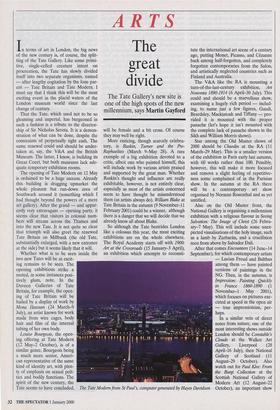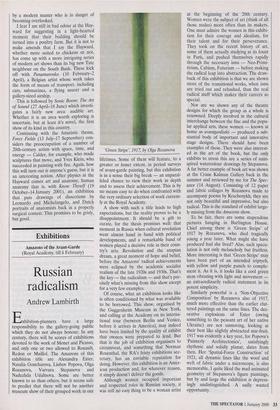ARTS
The great divide
The Tate Gallery's new site is one of the high spots of the new millennium, says Martin Gayford
I n terms of art in London, the big news of the new century is, of course, the split- ting of the Tate Gallery. Like some primi- tive, single-celled creature intent on procreation, the Tate has slowly divided itself into two separate organisms, named — after lengthy cogitation by the lone par- ent — Tate Britain and Tate Modern. I must say that I think this will be the most exciting event in the placid waters of the London museum world since the last change of century.
That the Tate, which used not to be so gleaming and imperial, has burgeoned in such a fashion is a tribute to the director- ship of Sir Nicholas Serota. It is a demon- stration of what can be done, despite the constraints of perpetually tight cash. The same renewal could and should be under- taken at, say, the V&A and the British Museum. The latter, I know, is building its Great Court, but both museums Tack ade- quate temporary exhibition rooms.
The opening of Tate Modern on 12 May is ordained to be a huge success. Already this building is dragging upmarket the whole pleasant but run-down area of Southwark around it (something which I had thought beyond the powers of a mere art gallery). After the grand — and appar- ently very extravagant — opening party, it seems clear that visitors in colossal num- bers will stream across the Thames and into the new Tate. It is not quite so clear that triumph will also greet the renewed Tate Britain on Millbank (the old Tate, substantially enlarged, with a new entrance at the side) but it seems likely that it will.
Whether what is to be seen inside the two new Tates will be as excit- ing remains to be seen. The opening exhibitions strike a muted, in some instances posi- tively glum, note. In the Duveen Galleries of Tate Britain, for example, the open- ing of Tate Britain will be hailed by a display of work by Mona Hatoum (24 March-9 July), an artist known for work made from wire cages, body hair and film of the internal tubing of her own body.
Louise Bourgeois, the open- ing offering at Tate Modern (12 May-2 October), is of a similar genre, Bourgeois being a much more senior, Ameri- can representative of the same kind of identity art, with plen- ty of emphasis on sexual poli- tics and bodily functions. The spirit of the new century, the Tate seems to have concluded, will be female and a bit cross. Of course they may well be right.
More enticing, though scarcely celebra- tory, is Ruskin, Turner and the Pre- Raphaelites (March 9-May 28). A rare example of a big exhibition devoted to a critic, albeit one who painted himself, this will include work by various artists praised and supported by the great man. Whether Ruskin's thought and influence are really exhibitable, however, is not entirely clear, especially as most of the artists concerned seem to have thought he misunderstood them (as artists always do). William Blake at Tate Britain in the autumn (9 November-11 February 2001) could be a winner, although there is a danger that we will decide that we already know all about Blake.
So although the Tate bestrides London like a colossus this year, the most exciting exhibitions are on the whole elsewhere. The Royal Academy starts off with 1900: Art at the Crossroads (15 January-3 April), an exhibition which attempts to reconsti- The Tate Modern from St Paul's, computer generated by Hayes Davidson tute the international art scene of a century ago, putting Monet, Picasso, and Cezanne back among half-forgotten, and completely forgotten contemporaries from the Salon, and artistically neglected countries such as Finland and Australia.
The V&A like the RA is mounting a turn-of-the-last-century exhibition, Art Nouveau 1890-1914 (6 April-30 July). This could and should be a marvellous show, examining a hugely rich period — includ- ing, to name just a few figures, Gaudi, Beardsley, Mackintosh and Tiffany — pro- vided it is mounted with the proper panache (let's hope it isn't mounted with the complete lack of panache shown in the Sikh and William Morris shows).
Star among the Old Master shows of 2000 should be Chardin at the RA (11 March-29 May). This is a smaller version of the exhibition in Paris early last autumn, with 60 works rather than 100. Possibly, however, this will make it more focused and remove a slight feeling of repetitive- ness some complained of in the Parisian show. In the autumn at the RA there will be a contemporary art show organised by Norman Rosenthal and as yet untitled.
Also an the Old Master front, the National Gallery is organising a millennium exhibition with a religious flavour in Seeing Salvation: The Image of Christ (26 Febru- ary-7 May). This will include some unex- pected visualisations of the holy image, such as a lamb by Zurbaran, and a crucifixion seen from above by Salvador Dali.
After that comes Encounters (14 June-14 September), for which contemporary artists — Lucian Freud and Balthus among them — have painted versions of paintings in the NG. Then, in the autumn, is Impression: Painting Quickly in France 1860-1890 (1 November-1 May 2001), which focuses on pictures exe- cuted at speed in the open air — true impressionism, per- haps.
In a similar vein of direct notes from nature, one of the most interesting shows outside London should be Constable's Clouds at the Walker Art Gallery, Liverpool (28 April-16 July), then National Gallery of Scotland (11 August-29 October). Also watch out for Paul Klee: From the Burgi Collection at the Scottish National Gallery of Modern Art (12 August-22 October), an important show by a modern master who is in danger of becoming overlooked.
I fear I am still in bad odour at the Hay- ward for suggesting in a light-hearted moment that their building should be turned into a poultry farm. But it is not to make amends that I say the Hayward, whether more suited to chickens or not, has come up with a more intriguing series of modern art shows than its big new Tate neighbour on the South Bank. These kick off with Panamarenko (10 February-2 April), a Belgian artist whose work takes the form of means of transport, including cars, submarines, a flying saucer and a gallery-sized airship. This is followed by Sonic Boom: The Art of Sound (27 April-18 June) which investi- gates a fairly new area: audible art. Whether it is an area worth exploring is uncertain, but at least it's novel, the first show of its kind in this country.
Continuing with the futuristic theme, Force Fields (13 July-17 September) con- siders the preoccupation of a number of 20th-century artists with space, time, and energy — Calder, for example, who made sculptures that move, and Yves Klein, who succeeded in painting with fire. Again, how this will turn out is anyone's guess, but it is an interesting notion. After physics at the Hayward comes art and anatomy, human anatomy that is, with Know Thyself (19 October-14 January 2001), an exhibition that puts drawings of dissections by Leonardo and Michelangelo, and Dutch portraits of anatomists back in a properly surgical context. This promises to be grisly, but good.



















































 Previous page
Previous page